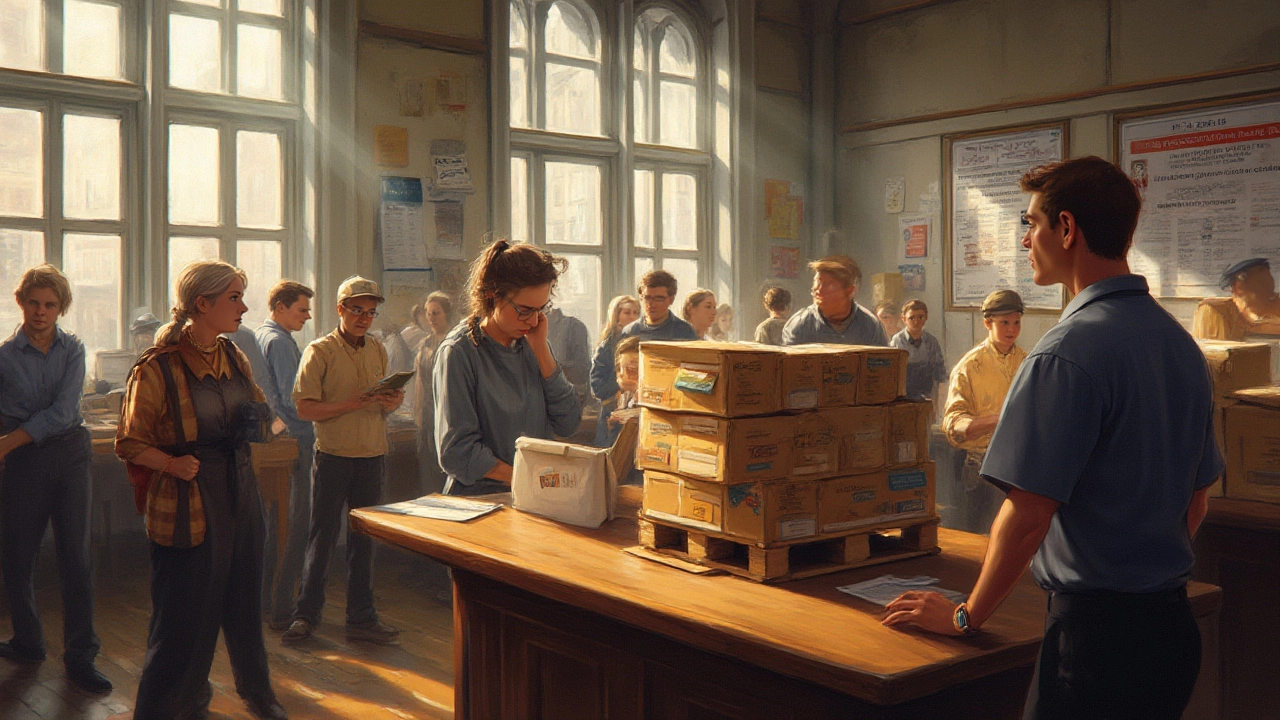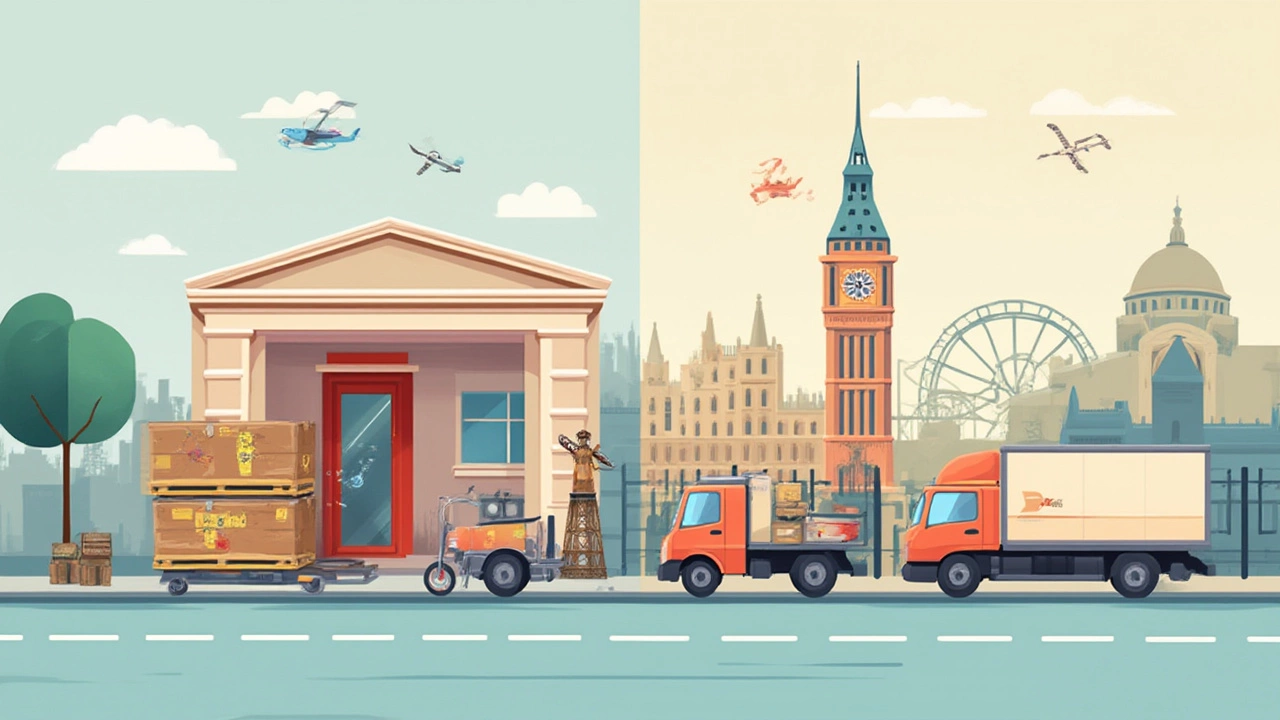Will USPS Deliver Pallets? Shipping Limits, Options, and the Real Scoop

Ever thought of mailing a giant pallet through your local post office? Plenty of people look at big stacks of boxes and wonder, “Could I just shrink-wrap this whole thing, slap on a label, and let the mailman haul it away?” The idea sounds wild—and maybe a little tempting if you’re running a small business or cleaning out the garage. The reality is that USPS has some pretty clear rules, and sending a pallet isn’t as simple as sending a regular package. But, let’s dig deep because there are some twists, exceptions, and even a few clever workarounds for those monster shipments.
How Big Is Too Big? What USPS Says About Pallet Shipping
So, can you haul a whole pallet to USPS and expect them to take it off your hands? Put simply—no. USPS does not deliver pallets in the traditional sense. Their services just aren’t set up for that kind of bulk. The post office is all about letters, small to medium packages, and the occasional large box. But their limits are written in stone: the biggest thing you can ship through regular USPS services is a box up to 70 pounds and up to 130 inches in combined length and girth (think: diameter around the thickest part plus length). Try to wheel a pallet—often 40 inches by 48 inches and weighing hundreds of pounds—into your local branch, and you’ll get a polite “no way.”
Still, this isn’t some old-school policy from the days of horse-drawn carriages. These rules are current as of 2025. They’ve stood the test of time because USPS simply isn’t built for forklifts and truckloads of shrink-wrapped freight. Their fleet of vehicles can’t handle that sort of thing. Plus, imagine the chaos if every post office suddenly turned into a mini freight terminal!
Here’s a fun fact: according to the USPS Postal Explorer, if your package weighs over 70 pounds, it’s automatically rejected, even if it’s just a few ounces over. That’s why big businesses turn to FedEx Freight, UPS Freight, or local trucking outfits when they need to move whole pallets.
Check out this comparison of typical pallet and USPS package limits:
| Type | Max Weight | Max Size |
|---|---|---|
| Standard USPS Package | 70 lbs | 130" length/girth combined |
| Standard Pallet | 1,200-4,600 lbs | 48"x40" (and up to 6+ ft tall) |
To sum it up: if it fits on a pallet, it’s way outside USPS limits. But that’s not the end of the story. Things get interesting once you dig into how creative folks work around these limits when shipping big stuff.

Workarounds, Tricks, and Alternatives When You Need to Ship Something Huge
Alright, so standard pallet shipping isn’t a USPS thing. But let’s say you have a mountain of boxes, each one in perfect shape for mailing. What are your real options? First, you could break down your shipment into smaller boxes, each one under that 70-pound, 130-inch threshold. Some sellers do exactly that, sending out 30 or 40 boxes (yep, the postal workers just love those). It isn’t pretty, but it works—and if you’re using Priority Mail or Priority Mail Express, you get tracking and delivery in 1-3 days nearly everywhere in the U.S.
Certain situations can make this approach pricey, fast. Who pays for all those boxes, the extra packaging, and labor? If you’re shipping something super heavy—like bags of concrete, cases of drinks, or metal hardware—there’s just no way to make it cost-effective. That’s when you have to step outside the post office.
Enter LTL (less-than-truckload) freight companies. Think FedEx Freight, UPS Freight, Old Dominion, or regional haulers. If you have something that actually does require a pallet—or five or ten—these carriers are ready for your business. They’ll send a truck, offer liftgate service if you don’t have a loading dock, and give you tracking just like USPS—but on a much bigger scale.
Let’s make this practical. Say you’re moving thirty boxes of auto parts from New York to Nevada, each one 50 pounds. If you try to send them all with USPS, you’ll need to split them up, pay shipping on every single box, and probably spend many hours on the process. Compare that to just strapping everything on a pallet, calling an LTL carrier, and handing off the whole shipment in one go. The LTL route is often cheaper per pound, less hassle, and way easier to track.
For smaller businesses or individuals, you can sometimes cut costs by teaming up with a friend or neighbor who’s shipping at the same time. Many LTL carriers offer "shared" pallet space, so you only pay for what you need on the truck. While USPS doesn’t offer this, it’s a popular trick with freight companies and can really help keep costs down.
Here’s a little-known tip: Some businesses will build wooden crates that fit within USPS’s legal limits and call them “mini-pallets.” As long as they fit under the weight and size rules, and you label them properly, the post office will accept them. But don’t get carried away—anything too big or heavy is still a no-go.
In addition, there are freight forwarding services, which will sometimes take your items, consolidate them, and then ship them via the post office or another carrier. These services are super useful for international shipments, though they usually don’t work for pallets, as those are considered “cargo” and handled differently from postal packages.
The big takeaway? USPS is not your answer for real pallet shipping, but for big-volume, small-package shipping, it still has a place—especially with zones where Priority Mail gives small businesses a fighting chance with fast, trackable delivery at a predictable rate.

Hidden Dangers and Money-Saving Tips: What Happens If You Push USPS Package Limits?
Let’s get real for a second. The temptation to sneak by a slightly oversized box, or fudge the weight, is strong—especially if you’re dealing with dozens of shipments and deadlines are tight. But USPS has eyes everywhere. Their packages go through automated systems that scan, weigh, and sometimes even measure your parcels. If there’s a mismatch, your box can get delayed, sent back, or re-routed for extra charges. That’s frustrating for everyone, and the extra fees aren’t cheap. USPS is not shy about charging you for the difference if your package exceeds the official limits.
If you try to send a box that’s too heavy, the digital kiosk will just freeze you out, or the clerk will send you home to re-pack. Even slightly oversized items might get away for a local shipment but can get held up, sometimes for weeks, at sorting centers far from your destination. There are public stories of people waiting months for oversized packages to get returned after the system flagged them. Save yourself the trouble: weigh and measure every box before heading to the post office, especially if you’re cutting things close.
A lot of online sellers use shipping software or scales at home to make sure their packages meet standards. Investing in a decent digital scale and a yardstick saves you headaches—and possibly hundreds in fees. USPS also publishes a handy online calculator that’ll show you exactly what’s allowed, and even help you figure out the cheapest service based on destination and speed. Don’t wing it if your profits depend on tight margins; a single mistake adds up fast when multiplied over many shipments.
Let’s talk money-saving. Flat Rate boxes from USPS remain a sweet spot for heavy, small-ish shipments. If it fits and it ships (yes, that old slogan), the price is locked in—whether your box has a stack of books, jars of jam, or tiny electronics. For businesses selling one-size-fits-all products, designing your packaging around these dimensions is a genius move. Imagine mailing 50 pounds of steel parts across the country for the same price as a few phone cases. If you’re shipping valuable goods, consider Priority Mail Express for speed and $100 of free insurance. It’s not perfect for everything, but it’s a lifesaver for deliveries needing tracked, signature-required, or insured service.
A quick warning: Pallets are almost always off-limits for international shipping via USPS. Customs forms demand accurate counts and weights, and massive bulk shipments often fall into "cargo" rather than "mail" categories. If you need to ship abroad, always do your homework or you might find your shipment stuck in limbo—or even seized.
Here’s another pro tip: If you only need to send a pallet occasionally and don’t want to open a business account with a freight company, ask your local hardware store, appliance retailer, or farm supply for leftover pallet space. Some stores let small shippers "hitch a ride" on outgoing deliveries, especially if you’re local. It won’t work for everyone, but it’s worth asking.
Finally, don’t forget about insurance. USPS covers lost or damaged packages up to a certain point, but once you’re out of the regular mail stream (i.e., shipping by freight), it’s on you to insure the whole value. Many freight shippers offer this as a built-in option or as an add-on service.
So, while the answer to "Does USPS deliver pallets?" is a hard no, shipping large and heavy stuff isn’t impossible—you just need the right strategy, a little hustle, and a solid understanding of what the USPS pallets policy actually is. Whether you’re moving house, running a business, or sending a mountain of goods across the country, there’s a way to get your stuff where it needs to go… even if it means thinking outside the box—or the pallet.